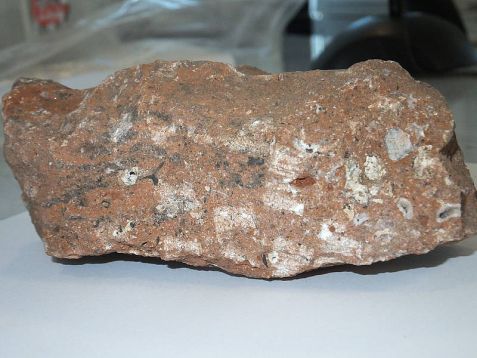MLZ is a cooperation between:
 > Technische Universität München
> Technische Universität München > Helmholtz-Zentrum Hereon
> Helmholtz-Zentrum Hereon
 > Forschungszentrum Jülich
> Forschungszentrum Jülich
MLZ is a member of:
 > LENS
> LENS > ERF-AISBL
> ERF-AISBL
MLZ on social media:

MLZ (eng)
Lichtenbergstr.1
85748 Garching
03.09.2013
Neutrons reveal enigma in archeology and paleontology

This breccia is from South Africa; clearly visible is the conglomeration of rock and baked pieces of bone. (Photo: C. Kortenbruck / TUM) © C. Kortenbruck / TUM
The first International Conference on imaging with neutrons in archeology and cultural heritage will take place from 9th to 12th of September 2013 at the Physics Department of the Technical University of Munich (TUM, James – Franck – Str. 1) on the Garching research campus. The special feature of this event is that for the first time physicists and archaeologists together organize a conference for neutron methods. Organizers are physicists from the neutron source Heinz Maier – Leibnitz (FRM II), TUM President Prof. Wolfgang Hermann acts as patron. The International Atomic Energy Agency supports the three -day event.
The neutrons of FRM II are widely used for research and analysis, but mainly for purposes of engineering and natural sciences. Neutron methods have the advantage that they work nondestructively and penetrate almost any material. This enables unique insights and creates spectacular and detailed images, such as the view of a running engine. Meanwhile, many archaeologists, paleontologists, curators and scientists dealing with the cultural heritage of mankind discovered this method for their purposes and already made experience with it all over the world. TUM President Hermann points out in his speech , as well as the organizing team led by Dr. Burkhard Schillinger (FRM II) that the first and so far unique conference will bring together primarily these scientists, share the experience, and also acts as a “nucleus for further meetings of this kind ,”. Schillinger, a nuclear physicist himself, who has analyzed a number of archaeological finds, will talk at the conference about his latest results from the investigation of breccia, a very old stone with inclusions, and will show, what surprises can be hidden in such samples. He especially applies methods of radiography and tomography with neutrons for imaging. These are particularly useful to the breccia from the Great African Rift Valley, called “cradle of mankind” because of the large number of paleoanthropological discoveries. Breccia is a kind of “pudding- like” rock, containing sometimes a few million years old bones and relics together with stone. With neutron radiography, it is possible to make the inclusions visible without destroying the rock.
Almost 100 scientists from Europe, South Africa, China, and Southeast Asia take part in the conference and report on the results of their findings. They talk about fossils and relics from the Iron Age in Poland, Greco-Roman bronzes, historical stones from Malaysia, ceramics from the Brazilian colonial period, but also Rembrandt paintings. However, radiography and tomography are not the only neutron methods that can be used to study this type of samples. Some of the participating scientists have used a technique known as Prompt Gamma Activation Analysis: The samples are exposed to a neutron beam, which activates some atomic nuclei, which then decay in a characteristic way. From this, a quantitative elemental and isotopic content can be determined, for example to determine the age of color pigments from the composition. The advantage of this method is that it also works completely non-destructive and uses only a very small sample volume.
The conference also highlights other aspects of archeology such as virtual excavations and reconstructions or exploring the workmanship of archaeological objects by neutron tomography. Interested participants may participate on Tuesday, 10th of October at 18 o’clock in a tour of the FRM II and take it a look at the neutron instruments.
Contact:
Dr. Burkhard Schillinger
Neutronentomographie ANTARES
Forschungsreaktor FRM-II
Technische Universität München
D-85747 Garching
Germany
Phone. +49 89 2891-2185
Email: Burkhard.Schillinger@frm2.tum.de
Press Contact:
Christine Kortenbruck / Andrea Voit
Forschungs-Neutronenquelle Heinz Maier-Leibnitz
TU München
Lichtenbergstr.1
85748 Garching
Phone: 089.289-13893
Email: presse@frm2.tum.de
MLZ is a cooperation between:
 > Technische Universität München
> Technische Universität München > Helmholtz-Zentrum Hereon
> Helmholtz-Zentrum Hereon
 > Forschungszentrum Jülich
> Forschungszentrum Jülich
MLZ is a member of:
 > LENS
> LENS > ERF-AISBL
> ERF-AISBL
MLZ on social media:


